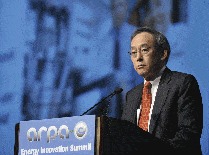The U.S. Department of Energy Secretary Steven Chu announced in April that up to $130 million from the Advanced Research Projects Agency-Energy (ARPA-E) will be made available to develop five new program areas that could spark critical breakthrough technologies.

The announcement is ARPA-E’s fourth round of funding opportunities, focusing on rare earth alternatives and breakthroughs in biofuels, thermal storage, grid controls, and solar power electronics.
The new program area of plants engineered to replace oil (PETRO), aims to create plants that capture more energy from sunlight and convert that energy directly into fuels. Technologies for low-cost production of advanced biofuels are limited by the small amount of available energy captured by photosynthesis and the inefficient processes used to convert plant matter to fuel. ARPA-E seeks to fund technologies that optimize the biochemical processes of energy capture and conversion to develop robust, farm-ready crops that deliver more energy per acre with less processing prior to the pump. If successful, PETRO will create biofuels for half their current cost, rendering them cost-competitive with fuels from oil. Up to $30 million will be made available for this program area.
More than 90% of energy technologies involve the transport and conversion of thermal energy. Therefore, advancements in thermal energy storage—both hot and cold—would dramatically improve performance for a variety of critical energy applications. In its new program on high energy advanced thermal storage (HEAT), ARPA-E seeks to develop revolutionary cost-effective thermal energy storage technologies in three focus areas: (1) high-temperature storage systems to deliver solar electricity more efficiently around the clock and allow nuclear and fossil base-load resources the flexibility to meet peak demand, (2) fuel produced from the sun’s heat, and (3) HVAC systems that use thermal storage to improve the driving range of electric vehicles by up to 40%. Up to $30 million will be made available for this program area.
Rare earths are naturally occurring minerals with unique magnetic properties that are used in many emerging energy technologies. As demand for these technologies continues to increase, rare earths are rapidly becoming more expensive due to limited global supply— prices of many have increased 300–700% in the past year. Rising rare earth prices have already escalated costs for some energy technologies and may jeopardize the widespread adoption of many critical energy solutions by U.S. manufacturers. In its new technology area rare earth alternatives in critical technologies (REACT), ARPA-E seeks to fund early-stage technology alternatives that reduce or eliminate the dependence on rare earth materials by developing substitutes in two key areas: electric vehicle motors and wind generators. Up to $30 million will be made available for this program area.
Recent advances in computation, networking, and grid monitoring have shed light on potential ways to deliver electricity more efficiently and reliably. Currently, however, the equivalent of one out of every five electricity dollars is lost to power outages and 30% of the grid’s hardware needs replacing. In the green electricity network integration (GENI) program, ARPA-E seeks to fund innovative control software and high-voltage hardware to reliably control the grid, specifically: (1) controls able to manage 10 times more sporadically available wind and solar electricity than currently on the grid, and (2) resilient power flow control hardware—or the energy equivalent of an internet router—to enable significantly more electricity through the existing network of transmission lines. Up to $30 million will be made available for this program area.
The fifth new technology area is on solar agile delivery of electrical power technology (Solar ADEPT). The DOE SunShot Initiative leverages the unique strengths across DOE to reduce the total cost of utility-scale solar systems by 75% by the end of the decade. If successful, this collaboration would deliver solar electricity at roughly six cents per kilowatt hour—a cost competitive with electricity from fossil fuels. This would enable solar electricity to scale without subsidies and make the United States globally competitive in solar technology. ARPA-E’s portion of the collaboration—the Solar ADEPT program—focuses on integrating advanced power electronics into solar panels and solar farms to extract and deliver energy more efficiently. Specifically, ARPA-E aims to invest in key advances in magnetics, semiconductor switches, and charge storage, which could reduce power conversion costs by up to 50% for utilities and 80% for homeowners. Up to $10 million will be made available for this program area.
The five technology areas announced in April will join ARPA-E’s seven existing programs in power electronics (ADEPT), battery technologies (BEEST), building cooling (BEETIT), non-photosynthetic biofuels (Electro-fuels), grid energy storage (GRIDS), carbon capture (IMPACCT), and its initial open solicitation.
In its first year, ARPA-E awarded $363 million in Recovery Act funding to 121 groundbreaking energy projects based in 30 states, with approximately 39% of projects led by universities, 33% by small businesses, 20% by large businesses, 5% by national laboratories, and 3% by non-profits.
More information about ARPA-E, current funding opportunities, and previously announced awards can be accessed at http://arpa-e.energy.gov/.


